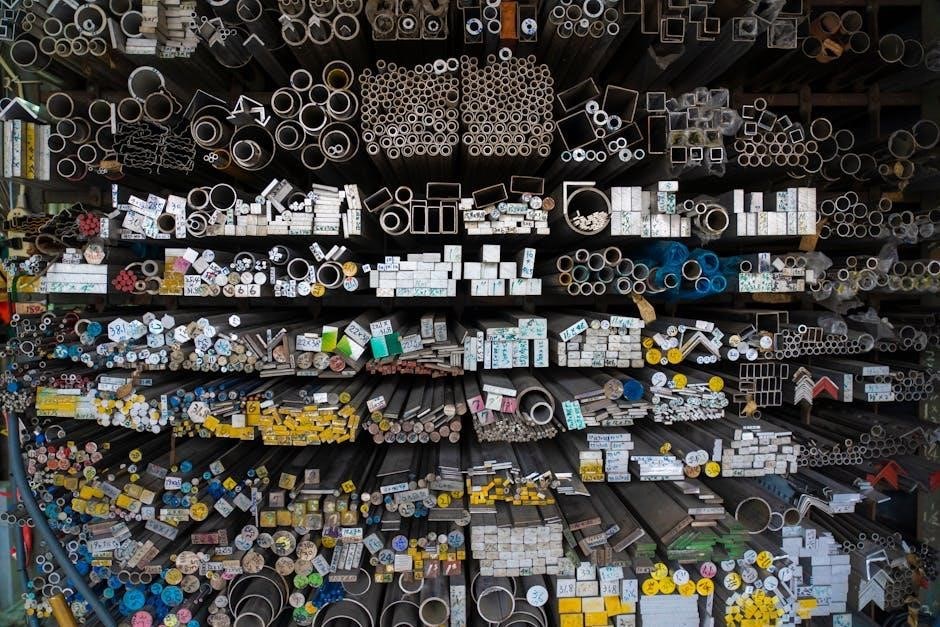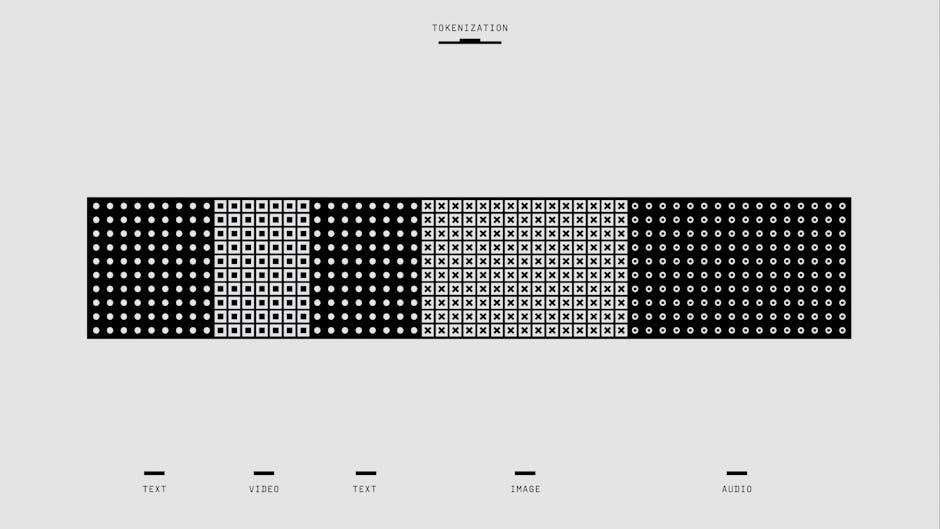ASME Section VIII Division 1 provides design requirements for pressure vessels to ensure safety under operating pressures․ It is part of the ASME Boiler and Pressure Vessel Code, widely recognized for governing the construction of boilers and pressure vessels․ This section focuses on ensuring structural integrity and compliance with safety standards, making it a critical reference for engineers and manufacturers worldwide․
Overview of ASME Section VIII Division 1
ASME Section VIII Division 1 is a comprehensive standard within the ASME Boiler and Pressure Vessel Code, governing the design, construction, and inspection of pressure vessels․ It provides detailed requirements for materials, fabrication, and testing to ensure safety and structural integrity․ This division is widely adopted across industries such as oil and gas, chemical processing, and power generation․ It emphasizes compliance with specific design calculations, stress analysis, and quality control measures․ The standard ensures that pressure vessels can withstand operational pressures and stresses, minimizing risks of failure․ By adhering to Division 1, manufacturers and engineers can guarantee the reliability and safety of pressure vessels in various industrial applications․
Historical Background of ASME and Section VIII
ASME, the American Society of Mechanical Engineers, was established in 1880 as a non-profit organization dedicated to advancing engineering knowledge․ The ASME Boiler and Pressure Vessel Code, including Section VIII, emerged in response to the need for standardized safety protocols․ Initially developed in the early 20th century, Section VIII Division 1 was introduced to address the construction of pressure vessels, ensuring they could safely withstand operational pressures․ Over the years, the section has undergone revisions to incorporate advancements in materials science and design engineering․ Today, it remains a cornerstone of pressure vessel design, trusted globally for its rigorous standards and commitment to safety, reflecting ASME’s legacy of promoting innovation and reliability in mechanical engineering․
Importance of ASME Section VIII Division 1 in Pressure Vessel Design
ASME Section VIII Division 1 is crucial for ensuring the safety and reliability of pressure vessels in various industries․ It provides standardized design, fabrication, and inspection requirements, minimizing risks of failure and ensuring compliance with legal and regulatory standards․ This section is particularly vital for industries like oil, gas, and power generation, where pressure vessels operate under extreme conditions․ By adhering to its guidelines, manufacturers can ensure structural integrity, material compliance, and operational safety, protecting both people and the environment․ Its widespread adoption underscores its role in maintaining public safety and advancing engineering practices globally, making it indispensable for modern industrial applications and cost-effective solutions․

Scope and Application of ASME Section VIII Division 1
ASME Section VIII Division 1 applies to the design, materials, and manufacturing of pressure vessels, excluding nuclear components․ It serves various industries requiring high-pressure containment solutions․
Pressure Vessels Covered Under Section VIII Division 1
Section VIII Division 1 encompasses a wide array of pressure vessels, including boilers, storage tanks, and process vessels․ It applies to vessels operating at internal or external pressures exceeding 15 psig, with specific guidelines for different materials and operating conditions․ The section covers both metallic and non-metallic vessels, ensuring safety across various industrial applications․ It excludes nuclear components, focusing instead on commercial and industrial pressure containment solutions․ Compliance with these standards is essential for ensuring the structural integrity and safety of pressure vessels in diverse sectors, from petrochemical to power generation․
Exclusions and Limitations of ASME Section VIII Division 1
ASME Section VIII Division 1 excludes certain types of pressure vessels, such as those classified as nuclear components, which fall under Division 3․ It does not cover vessels operating below 15 psig or those with specific design complexities requiring specialized codes․ Additionally, it excludes non-pressure-retaining components and does not address in-service operation or maintenance․ The section primarily focuses on new vessel construction, leaving modifications and repairs to other standards․ These exclusions ensure the code remains tailored to specific applications, maintaining clarity and safety without overcomplicating with unrelated requirements․ Understanding these limitations is crucial for proper application and compliance with the standard․
Industry Sectors That Rely on ASME Section VIII Division 1

ASME Section VIII Division 1 is integral to various industries requiring pressure vessels, including oil and gas, chemical processing, power generation, and food and beverage․ The chemical industry relies on it for reactors and storage tanks, while the power sector uses it for boilers and heat exchangers․ Additionally, pharmaceutical and aerospace industries depend on its guidelines for specialized pressure vessels․ The standard ensures compliance with safety and design requirements, making it a cornerstone for these sectors to meet regulatory demands and maintain operational integrity․ Its widespread adoption reflects its critical role in ensuring the safe and efficient operation of pressure vessels across diverse applications․

Design Requirements and Calculations
ASME Section VIII Division 1 outlines design fundamentals, stress analysis, and material compliance for pressure vessels; It ensures structural integrity through precise calculations and safety standards․
Design Fundamentals for Pressure Vessels
Design fundamentals for pressure vessels under ASME Section VIII Division 1 focus on ensuring structural integrity and safety․ The code provides specific criteria for vessel geometry, material selection, and stress analysis․ Engineers must consider factors like operating pressure, temperature, and load conditions to design vessels that withstand operational stresses․ The section emphasizes the importance of finite element analysis and other advanced methods to validate designs․ Compliance with these fundamentals ensures that pressure vessels operate safely and efficiently across various industries, adhering to rigorous safety standards and minimizing failure risks․

Material Selection and Compliance
Material selection is critical in ASME Section VIII Division 1, ensuring pressure vessels are fabricated from materials that meet specific mechanical and thermal requirements․ The code outlines detailed criteria for material properties, including strength, toughness, and resistance to corrosion․ Compliance involves verifying that materials are certified and traceable, with proper documentation to ensure reliability․ Engineers must adhere to ASME standards for material testing and certification, avoiding the use of non-compliant materials that could compromise safety․ Proper material selection and compliance are essential for maintaining the structural integrity and operational safety of pressure vessels across various industries․
Design Calculations and Stress Analysis
Design calculations and stress analysis are fundamental to ensuring pressure vessels meet ASME Section VIII Division 1 requirements․ Engineers must perform detailed computations to verify that designs can withstand operational stresses, including internal pressure, thermal loads, and external forces․ The code provides formulas and methods for calculating stress in various components, such as shells, heads, and nozzles․ Finite element analysis is often used to validate complex geometries․ Compliance with these calculations ensures the vessel’s structural integrity and safety․ Documentation of these analyses is critical for certification and must adhere to ASME standards․ Proper stress analysis prevents failures and guarantees reliable performance under harsh operating conditions․

Fabrication and Manufacturing Process
Fabrication of pressure vessels under ASME Section VIII Division 1 involves strict compliance with material selection, cutting, forming, and assembly processes․ Techniques like welding and machining are carefully executed to meet code requirements, ensuring structural integrity and safety․ Quality control measures, including non-destructive testing, are applied to verify compliance․ Manufacturers must adhere to detailed fabrication steps to achieve certification, guaranteeing reliable performance under operational conditions․
Fabrication Steps for ASME Section VIII Division 1 Compliance
The fabrication process under ASME Section VIII Division 1 involves precise steps to ensure compliance․ It begins with material selection, where components are chosen based on their mechanical properties and compatibility with design requirements․ Cutting and forming operations follow, with careful attention to dimensional accuracy and surface finish; Welding is a critical step, requiring qualified procedures and personnel to meet code standards․ Post-weld heat treatment may be necessary to relieve stresses and ensure material integrity․ Non-destructive testing (NDT) methods, such as radiography or ultrasonic testing, are applied to detect any defects․ Final assembly includes fitting and alignment of components, followed by leakage testing․ Documentation of each step is maintained for traceability and certification purposes, ensuring the vessel meets all safety and design criteria․
Inspection and Quality Control Measures
Inspection and quality control are critical in ensuring compliance with ASME Section VIII Division 1․ Rigorous non-destructive testing (NDT) methods, such as radiography, ultrasonic testing, and magnetic particle testing, are employed to detect defects in welds and materials․ Dimensional inspections verify vessel dimensions against design specifications․ Material verification ensures all components meet required specifications․ Quality control measures include documentation of fabrication steps, traceability of materials, and adherence to welding procedures․ Authorized Inspectors oversee the process, witnessing critical tests and verifying compliance․ Final inspections include hydrostatic testing to ensure the vessel can withstand design pressures safely․ These measures collectively ensure the pressure vessel’s structural integrity, reliability, and compliance with ASME standards, minimizing risks during operation․
Welding and Fabrication Requirements
ASME Section VIII Division 1 specifies stringent welding and fabrication requirements to ensure pressure vessels are constructed safely and reliably․ Welding procedures must be qualified and documented, with welders certified to ASME standards․ Joint designs, filler materials, and welding techniques are carefully detailed to prevent defects․ Post-weld heat treatment is often required to relieve stresses and ensure material properties․ Fabrication steps must adhere to approved procedures, with thorough documentation maintained․ Quality control measures, such as visual and non-destructive testing, verify compliance․ These requirements ensure welded joints meet the strength and durability needed for safe operation under design pressures․ Compliance with these standards is essential for maintaining the integrity and reliability of pressure vessels in various industrial applications․

Inspection, Testing, and Certification
ASME Section VIII Division 1 mandates rigorous inspection, testing, and certification processes to ensure pressure vessels meet safety and design standards․ Non-destructive testing methods, like ultrasonic and radiographic inspections, are employed to detect flaws․ Hydrostatic and pneumatic tests verify vessel integrity under pressure․ Certification involves documenting compliance with ASME standards, including material traceability and welding records․ Third-party inspectors often oversee these processes to ensure adherence to code requirements․ Proper certification ensures operational safety and regulatory compliance, critical for industrial applications․
Pre-Service and In-Service Inspections
Pre-service inspections ensure pressure vessels meet ASME Section VIII Division 1 standards before initial operation․ These checks verify design compliance, material quality, and welding integrity․ In-service inspections monitor vessel condition during operation, detecting potential degradation․ Procedures include visual examinations, non-destructive testing (NDT), and thickness measurements to identify corrosion or wear․ Pressure testing is also conducted to validate structural integrity․ Records of these inspections are maintained for compliance and future reference․ Regular inspections help prevent failures, ensuring safety and extending vessel lifespan․ They are critical for maintaining operational reliability and meeting regulatory requirements, safeguarding both personnel and equipment․
Non-Destructive Testing (NDT) Methods
Non-Destructive Testing (NDT) methods are essential for ensuring compliance with ASME Section VIII Division 1 standards․ Common NDT techniques include radiographic testing (RT), ultrasonic testing (UT), magnetic particle testing (MT), and liquid penetrant testing (PT)․ These methods help detect defects without damaging the pressure vessel․ Radiography and ultrasonic testing are used to identify internal flaws, while magnetic particle and liquid penetrant tests reveal surface defects․ These inspections are critical for verifying weld quality and material integrity․ NDT ensures pressure vessels meet design requirements and are safe for operation․ Regular application of these methods helps maintain structural integrity and prevents potential failures․ Proper documentation of NDT results is required for certification and compliance with ASME standards․
Certification Process and Documentation
The certification process for ASME Section VIII Division 1 involves rigorous documentation and compliance verification․ Manufacturers must submit designs, materials, and test results for review by an Authorized Inspection Agency․ Documentation includes design calculations, material certificates, and test reports․ Upon passing inspections, a Certificate of Conformance is issued, allowing the use of the ASME Certification Mark․ Proper record-keeping ensures traceability and compliance with regulatory requirements․ ASME does not determine when a vessel should comply with Division 1; this decision lies with the manufacturer or jurisdiction․ Maintaining accurate documentation is critical for audits and future inspections․ This process ensures pressure vessels meet safety and design standards, providing assurance of their integrity and reliability․ Adherence to these steps is mandatory for certification under ASME Section VIII Division 1․

Safety and Compliance Considerations
ASME Section VIII Division 1 establishes design and operational guidelines to ensure pressure vessels operate safely under specified conditions, minimizing risks and ensuring compliance with industry standards․
Safety Codes and Standards for Pressure Vessels
The ASME Section VIII Division 1 provides comprehensive safety codes and standards for pressure vessels, ensuring they are designed, fabricated, and inspected to withstand operational pressures safely․ These codes outline material selection, design calculations, and fabrication techniques to prevent failures․ Compliance with these standards is mandatory in many industries to guarantee the structural integrity and safety of pressure vessels․ Adhering to these guidelines minimizes risks and ensures reliable performance under various operating conditions․ The standards are continuously updated to reflect advancements in technology and industry practices, making them a cornerstone of pressure vessel safety worldwide․
Risk Management and Hazard Analysis
ASME Section VIII Division 1 emphasizes risk management and hazard analysis to ensure pressure vessels operate safely and reliably․ The standard provides guidelines for identifying potential hazards, such as material failures or operational stresses, and mitigating risks through proper design and fabrication practices․ Engineers use techniques like Hazard and Operability Studies (HAZOP) and Failure Modes and Effects Analysis (FMEA) to assess risks․ Compliance with ASME standards ensures that pressure vessels are designed to withstand extreme conditions, minimizing the likelihood of accidents․ Regular inspections and maintenance are also critical components of risk management, as outlined in the code․ By adhering to these practices, industries can protect personnel, equipment, and the environment from potential hazards associated with pressure vessel operations․
Legal and Regulatory Compliance
ASME Section VIII Division 1 ensures legal and regulatory compliance by providing standardized requirements for pressure vessel design and construction․ Many jurisdictions worldwide adopt the ASME Boiler and Pressure Vessel Code into their laws, making compliance mandatory for manufacturers and operators․ The use of ASME’s certification marks, such as the “U” stamp, signifies adherence to these standards and is often required for legal operation․ Failure to comply can result in legal penalties, fines, and operational shutdowns․ The code also outlines documentation and certification processes to demonstrate compliance, ensuring that pressure vessels meet both safety and legal standards․ This makes ASME Section VIII Division 1 a cornerstone of regulatory adherence in industries utilizing pressure vessels․

Maintenance and Repair of Pressure Vessels
ASME Section VIII Division 1 emphasizes regular maintenance and repair of pressure vessels to ensure safety and longevity․ It outlines procedures for periodic inspections, repair techniques, and documentation to maintain compliance with safety standards and prevent failures․
Recommended Maintenance Practices
ASME Section VIII Division 1 recommends regular maintenance practices to ensure the longevity and safety of pressure vessels․ These practices include periodic inspections to identify wear and tear, cleaning of internal and external surfaces to prevent corrosion, and monitoring of operational parameters․ Vessels should be inspected for leaks, cracks, and other forms of damage, with repairs addressing any issues promptly․ Maintenance should be performed by trained personnel following ASME guidelines to ensure compliance․ Documentation of all maintenance activities is crucial for tracking the vessel’s condition and ensuring adherence to safety standards․ These practices help prevent unexpected failures and extend the service life of pressure vessels․
Repair Techniques and Welding Procedures
ASME Section VIII Division 1 outlines specific repair techniques and welding procedures for pressure vessels to ensure safety and structural integrity․ Repairs must comply with the Code, using qualified welding procedures and personnel․ Post-weld heat treatment (PWHT) is often required to relieve residual stresses and maintain material properties․ Non-destructive testing (NDT), such as ultrasonic or radiographic testing, is performed to verify weld quality․ All repairs must be documented and approved by a designated representative․ Welding procedures should follow ASME standards, ensuring compatibility of materials and techniques․ Proper repair techniques prevent future failures and extend the vessel’s lifespan while maintaining compliance with safety codes․
Documentation and Record-Keeping for Maintenance
Proper documentation and record-keeping are essential for maintaining compliance with ASME Section VIII Division 1․ Detailed records of maintenance activities, including inspection reports, repair details, and testing results, must be maintained․ These records should include dates, procedures followed, and personnel involved․ Digital documentation is often recommended for ease of storage and retrieval․ Traceability of materials and compliance with standards must be clearly documented․ Records should also include any deviations from standard procedures and corrective actions taken․ Regular audits of documentation ensure accuracy and adherence to ASME guidelines․ Proper record-keeping supports accountability, traceability, and safety, ensuring pressure vessels remain operational and compliant over their lifecycle․

Resources and References
ASME Section VIII Division 1 PDF resources are available on official ASME websites and authorized sellers․ Training programs and updates ensure compliance with the latest standards․
ASME Section VIII Division 1 PDF and Digital Resources
The ASME Section VIII Division 1 PDF and digital resources are available through the official ASME website and authorized distributors․ These resources provide detailed guidelines for pressure vessel design and construction, ensuring compliance with safety standards․ Professionals can access digital versions, including searchable PDFs, enhancing usability․ Digital tools and subscription services offer updates, ensuring users have the latest information; Accessing these resources is crucial for engineers and manufacturers to stay informed and adhere to current regulations․ The official ASME platform also offers training materials and updates, further supporting professionals in their work with pressure vessels effectively․
Training and Certification Programs
ASME offers comprehensive training and certification programs to equip professionals with in-depth knowledge of Section VIII Division 1 standards․ These programs cover design, fabrication, and inspection of pressure vessels, ensuring compliance with safety codes․ Participants gain hands-on experience through workshops and online courses, preparing them for real-world challenges․ Certifications are recognized industry-wide, enhancing career opportunities․ Customized training sessions are also available for organizations, tailored to their specific needs․ These programs emphasize practical application and adherence to ASME standards, fostering expertise in pressure vessel construction and maintenance․ Annual updates ensure trainees stay current with the latest revisions and industry practices, making these programs indispensable for professionals in the field․
Updates and Revisions to ASME Section VIII Division 1
ASME Section VIII Division 1 undergoes regular updates to reflect advancements in technology and industry needs․ These revisions ensure the standard remains relevant and enhances safety in pressure vessel design․ Recent updates include clarifications on design calculations and material specifications, as well as new guidelines for emerging manufacturing techniques․ Public review periods allow stakeholders to provide feedback, ensuring the revisions are comprehensive and practical․ ASME also releases official interpretations and errata to address specific inquiries or corrections․ These updates are documented in detail, providing clear guidance for engineers and manufacturers․ Staying informed about these changes is crucial for compliance and optimal pressure vessel performance․ Professionals are encouraged to refer to the latest ASME Section VIII Division 1 PDF for the most current information and requirements․